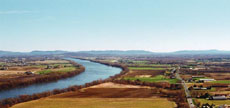
 |
| image size 39KB--jpeg |
Major rivers and streams draining areas of mixed land use contain pesticides from both agricultural and urban sources and from both past and present use. In water that comes mainly from agricultural areas, the most commonly found pesticides are the major herbicides atrazine (and DEA), metolachlor, cyanazine, and alachlor. In water that comes mainly from urban areas, the most common pesticides are the herbicides simazine and prometon and the insecticides diazinon and carbaryl.
Like water, the fish and bed sediment of major rivers and streams with mixed land-use influences contain mixtures of organochlorine insecticides from agricultural and urban areas. Detection frequencies and concentrations of DDT, dieldrin, and chlordane were generally intermediate between those of agricultural and urban streams.
Many large rivers with mixed land-use influences tend to have lower concentrations of pesticides compared with agricultural and urban streams because of a larger influence of undeveloped land. Some rivers in intensive agricultural regions, however, have concentrations that are similar to those in agricultural streams, although they are less variable over time. Rivers with mixed land uses almost always contain detectable pesticides that reflect the diversity of sources present.
In contrast, ground water in major aquifers has a substantially lower frequency of pesticide occurrence than shallow ground water in agricultural and urban areas. This difference results from the generally deeper wells sampled in major aquifers and the greater influence of undeveloped areas. Additionally, owing to the slow rate of ground-water flow, much of the water sampled in the major aquifers may have infiltrated into the ground before pesticides were applied. The two most frequently detected compounds in major aquifers were atrazine and DEA, resulting from the high and extensive use of atrazine, the greater extent of agricultural land compared to urban land affecting most major aquifers sampled, and the high mobility and long-lived nature of atrazine and DEA.
Because the pesticides found in major rivers and aquifers reflect contributions from both agricul-tural and urban land uses, efforts to improve the quality of these water resources will require management of nonpoint sources in both agricultural and urban areas.